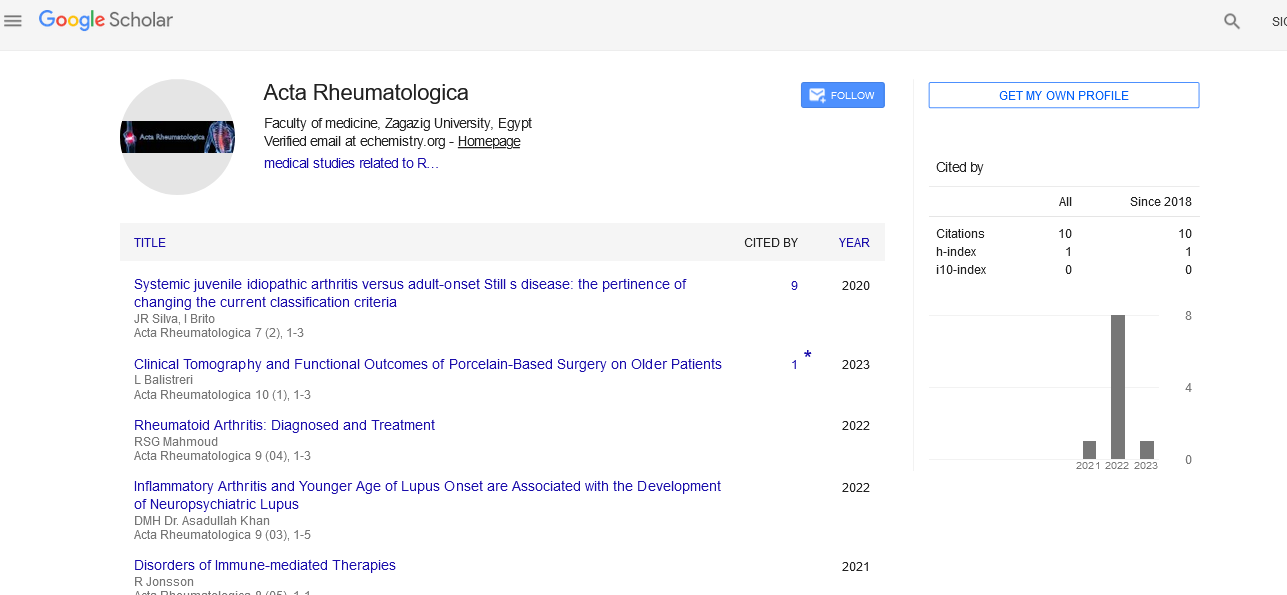Perspective - (2024) Volume 11, Issue 3
Pain Management: A Holistic Approach to Alleviating Suffering and Restoring Quality of Life
Brigitte Michelsen*
Department of Rheumatoid Arthritis, Roskilde University, Roskilde, Denmark
*Correspondence:
Brigitte Michelsen, Department of Rheumatoid Arthritis, Roskilde University, Roskilde,
Denmark,
Email:
Received: 16-May-2024, Manuscript No. IPAR-24-14802;
Editor assigned: 20-May-2024, Pre QC No. IPAR-24-14802 (PQ);
Reviewed: 04-Jun-2024, QC No. IPAR-24-14802;
Revised: 12-Jun-2024, Manuscript No. IPAR-24-14802 (R);
Published:
20-Jun-2024
Introduction
Pain is a universal human experience, serving as a vital signal
of injury or disease. However, when pain becomes chronic or
debilitating, it can profoundly impact an individual's physical,
emotional, and social well-being, posing significant challenges to
healthcare providers and patients alike. In this article, we
embark on a journey through the landscape of pain
management, exploring its multidimensional nature, underlying
mechanisms, assessment strategies, treatment modalities, and
the pivotal role of interdisciplinary care in improving outcomes
and restoring quality of life.
Pain is a complex sensory and emotional experience
influenced by biological, psychological, social, and environmental
factors. Nociception, the physiological process of detecting
noxious stimuli, serves as the foundation of pain perception,
encompassing peripheral sensory receptors, spinal cord
processing, and ascending pathways to the brain. However, pain
perception is modulated by cognitive, affective, and contextual
factors, shaping individual experiences and responses to pain.
Chronic pain, characterized by persistent nociceptive signaling or
maladaptive neuroplastic changes, represents a distinct entity
with profound implications for physical function, mood, and
quality of life.
Description
Assessment and diagnosis
Effective pain management begins with a comprehensive
assessment to understand the nature, severity, and impact of
pain on the individual's life. Pain assessment tools encompass
subjective self-report measures, such as numerical rating scales
and visual analog scales, as well as multidimensional instruments
evaluating physical function, mood, and quality of life. Diagnostic
evaluation aims to identify underlying causes of pain, including
musculoskeletal injuries, neuropathic disorders, inflammatory
conditions, or psychosocial stressors, guiding targeted
interventions and treatment strategies.
Multimodal treatment approaches
The management of pain necessitates a multimodal approach
tailored to the individual's unique needs, preferences, and
underlying pathology. Pharmacological interventions serve as
the cornerstone of pain management, encompassing
Nonsteroidal Anti-Inflammatory Drugs (NSAIDs), opioids,
antidepressants, anticonvulsants, and topical agents targeting
nociceptive pathways or neuropathic mechanisms. However, the
judicious use of medications requires careful consideration of
efficacy, safety, and the risk of adverse effects, particularly in the
context of opioid prescribing practices and the opioid epidemic.
No pharmacological interventions play a pivotal role in
augmenting pain management strategies, offering adjunctive
approaches to improve pain control, enhance function, and
promote self-management skills. Physical therapy, occupational
therapy, and rehabilitation programs focus on restoring
musculoskeletal function, improving mobility, and reducing
disability. Behavioral interventions, including Cognitive-Behavioral Therapy (CBT), Mindfulness-Based Stress Reduction
(MBSR), and relaxation techniques, target maladaptive pain-related
cognitions, emotions, and behaviors, fostering adaptive
coping strategies and resilience.
Interventional procedures and surgical options
For individuals with refractory or localized pain, interventional
procedures and surgical interventions may offer additional
therapeutic options. Epidural steroid injections, nerve blocks,
and radiofrequency ablation can provide targeted pain relief by
interrupting nociceptive signaling or modulating neural activity.
Surgical interventions, such as decompressive procedures, joint
replacement surgery, or neuromodulation techniques, may
be considered in select cases where conservative measures
have failed to alleviate pain or improve function.
The role of interdisciplinary care
Interdisciplinary pain management programs represent a
holistic approach to addressing the complex needs of individuals with chronic pain, integrating medical, rehabilitative, care
empowers individuals to reclaim their lives and achieve
meaningful improvements in function and well-being.
Conclusion
Pain management represents a multifaceted endeavor
aimed at alleviating suffering, restoring function, and improving
quality of life for individuals grappling with acute or chronic
pain. By embracing a holistic approach that addresses the
biological, psychological, social, and environmental factors
contributing to pain, healthcare providers can optimize treatment
outcomes and empower patients to reclaim control over their
lives. As we navigate the landscape of pain management, armed
with knowledge, compassion, and a collaborative ethos, we forge
a path towards a future where pain is managed effectively, and
individuals thrive in health and vitality.
Citation: Michelsen B (2024) Pain Management: A Holistic Approach to Alleviating Suffering and Restoring Quality of Life. Acta Rheuma Vol:11 No:3





